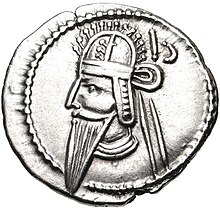Vologases VI
| Vologases VI | |
|---|---|
| King of Kings | |
 Coin of Vologases VI, minted atHamadan | |
| King of theParthian Empire | |
| Reign | 208 – 228 |
| Predecessor | Vologases V |
| Successor | Artabanus IV(rival king) Ardashir I(Sasanian Empire) |
| Died | 228 Mesopotamia |
| Father | Vologases V |
| Religion | Zoroastrianism |
Vologases VI(Parthian:Walagash,Persian:بلاش,Balāsh) was the uncontested king of theParthian Empirefrom 208 to 213, but afterwards fell into a dynastic struggle with his brotherArtabanus IV,[a]who by 216 was in control of most of the empire, even being acknowledged as the supreme ruler by theRoman Empire.Vologases VI continued to ruleSeleuciauntil 221/2, and coin mints of him even appear inMesopotamiauntil 228, when he was presumably defeated by theSasanian Empire,who had previously defeated Artabanus IV and now succeeded the Parthians as the kings ofIran.
Name[edit]
Vologases is theGreekandLatinform of theParthianWalagash.The name is also attested inNew PersianasBalāshandMiddle PersianWardākhsh(also spelledWalākhsh). The etymology of the name is unclear. A suggestion has been made that the name could mean "strength".[1]
Biography[edit]
Vologases VI succeeded his fatherVologases Vas king inc. 208.His rule was unquestioned for a few years, till his brotherArtabanus IVrebelled. The dynastic struggle between the two brothers most likely started inc. 213.Artabanus successfully conquered much of the empire, includingMediaandSusa.Vologases VI seems to have only managed to keepSeleucia,where he minted coins.[1]TheRomanemperorCaracallasought to take advantage of the conflict between the two brothers. He tried to find a pretext to invade the Parthian Empire by requesting Vologases to send two refugees—a philosopher named Antiochus and a certain Tiridates, who was possibly either an Armenian prince or an uncle of Vologases. To the surprise of the Romans, Vologases had the two men sent to Caracalla in 215, thus denying him his pretext.[1]Caracalla's choice of contacting Vologases instead of Artabanus shows that the Romans still saw him as the dominant king.[2]
Caracalla thus chose to preoccupy himself with an invasion ofArmenia.He appointed afreedmannamed Theocritus as the leader of the invasion, which eventually ended in a disaster. Caracalla then once again sought to start a war with the Parthians. In another attempt to gain a pretext, he requested Artabanus to marry his daughter, which he declined. It is disputed whether Caracalla's proposal was sincere or not.[1]Caracalla's choice to contact Artabanus shows that the latter was now considered the dominant king over Vologases, who would rule a small principality centered around Seleucia until 221/2. A few years later (224),Ardashir I(r. 224–242), the founder of theSasanian dynasty,defeated and killed Artabanus, thus putting an end to the Parthian Empire. Over the next few years, Ardashir I further expanded his new empire, and must have driven out or defeated Vologases inMesopotamiasoon after 228.[1][2]
Notes[edit]
- ^Artabanus IV is erroneously known in older scholarship as Artabanus V. For further information, seeSchippmann (1986a,pp. 647–650)
References[edit]
- ^abcdeChaumont & Schippmann 1988,pp. 574–580.
- ^abSchippmann 1986a,pp. 647–650.
Sources[edit]
- Chaumont, M. L.; Schippmann, K. (1988). "Balāš VI".Encyclopaedia Iranica, Vol. III, Fasc. 6.pp. 574–580.
- Schippmann, K. (1986a). "Artabanus (Arsacid kings)".Encyclopaedia Iranica, Vol. II, Fasc. 6.pp. 647–650.
- Schippmann, K. (1986b). "Arsacids ii. The Arsacid dynasty".Encyclopaedia Iranica, Vol. II, Fasc. 5.pp. 525–536.
